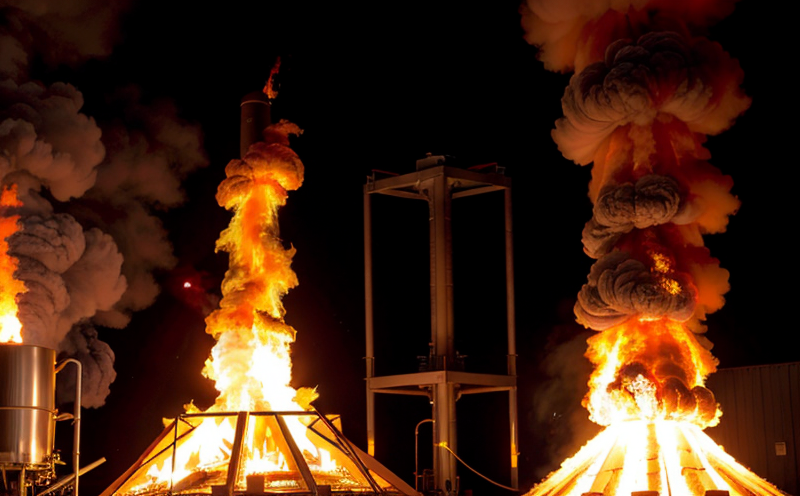Leather Flammability Testing
The safety and integrity of leather products are paramount in ensuring consumer protection and regulatory compliance. Leather flammability testing is a crucial aspect of quality assurance that evaluates the combustibility properties of leather materials under controlled conditions. This service ensures that leather goods meet stringent safety standards, thereby enhancing consumer confidence and market competitiveness.
Flammability tests for leather products are conducted using various internationally recognized methodologies such as ISO 13943:2018 and ASTM D6473-18. These protocols provide a standardized approach to assessing the flame resistance of materials by measuring their propensity to ignite, burn, or sustain combustion in specific environments.
The testing process involves preparing standard specimens of leather according to specified dimensions and conditions outlined in relevant standards. Once prepared, these samples are subjected to controlled thermal exposure within a test chamber. The duration and intensity of the heat source are carefully calibrated to simulate real-world scenarios where materials might be exposed to fire hazards.
During testing, critical parameters such as ignition temperature, flame spread rate, and after-flame time are meticulously recorded. These metrics help in determining the flammability characteristics of leather samples. The results of these tests provide valuable insights into the potential risks associated with using specific leather types or finishes, which can inform product design decisions and safety improvements.
Regular testing is essential for maintaining quality standards and ensuring compliance with international regulations. By adhering to rigorous testing protocols, manufacturers can develop safer products that meet consumer expectations and regulatory requirements. This not only enhances brand reputation but also minimizes the risk of recalls or legal actions associated with unsafe products.
The importance of leather flammability testing extends beyond mere compliance; it plays a vital role in safeguarding public health and safety. In sectors such as automotive, furniture manufacturing, and footwear production, where leather is widely used, this service helps identify potential hazards early on, allowing for timely interventions to mitigate risks.
Moreover, the results of these tests can influence design choices, leading to innovations that enhance both aesthetics and functionality while maintaining high safety standards. By leveraging advanced testing methodologies and continuous improvement practices, manufacturers can stay ahead in an increasingly competitive market, ensuring their products remain safe and reliable.
Quality and Reliability Assurance
The quality of leather flammability testing is underpinned by rigorous adherence to international standards such as ISO 13943:2018 and ASTM D6473-18. These standards provide a framework for consistent and reliable test results, ensuring that the data generated can be trusted across industries.
Our laboratory employs state-of-the-art equipment and highly trained technicians to conduct these tests with precision and accuracy. The use of advanced instrumentation ensures that each specimen is subjected to uniform conditions, minimizing variability in outcomes. This consistency is crucial for maintaining accurate and reproducible results.
The reliability of our testing services is further enhanced through regular calibration of instruments and ongoing staff training programs. By investing in cutting-edge technology and continuous professional development, we ensure that our laboratory remains at the forefront of industry best practices.
Customer satisfaction is a key priority for us. We strive to provide accurate, timely reports that meet or exceed client expectations. Our commitment to quality assurance extends beyond just meeting regulatory requirements; it encompasses delivering comprehensive insights into the flammability characteristics of leather materials.
To ensure transparency and ease of interpretation, all test results are documented in clear, easy-to-understand formats. This approach facilitates informed decision-making for our clients, enabling them to make strategic choices based on reliable data. By offering a high level of service excellence, we aim to build long-term relationships with trusted partners who value quality above all else.
Customer Impact and Satisfaction
The benefits of leather flammability testing extend far beyond compliance; they directly impact customer satisfaction and brand reputation. By ensuring that products meet rigorous safety standards, manufacturers can build trust with consumers and enhance their market position.
Achieving regulatory compliance through thorough testing not only protects end users but also demonstrates a commitment to ethical business practices. This approach fosters positive relationships with customers who are increasingly conscious of the environmental and social impacts of the products they purchase.
For quality managers, compliance officers, R&D engineers, and procurement teams alike, leather flammability testing provides valuable data that informs product development processes. It allows these professionals to make evidence-based decisions regarding material selection, design modifications, and manufacturing techniques.
The insights gained from these tests can lead to improvements in product safety features, which ultimately contribute to enhanced user experience. When customers feel safe using a product, they are more likely to recommend it to others, driving word-of-mouth marketing efforts that benefit the brand.
Moreover, successful compliance with flammability testing requirements can open up new market opportunities by expanding into regions or sectors where stringent safety regulations apply. This expansion not only increases revenue streams but also reinforces a company's reputation as a leader in product safety and innovation.
In summary, leather flammability testing plays an indispensable role in safeguarding public health and promoting responsible business practices. Its impact on customer satisfaction and brand reputation cannot be overstated, making it a crucial service for any organization committed to excellence in its products and services.
Competitive Advantage and Market Impact
Meeting rigorous flammability standards enhances a manufacturer's reputation as a leader in product safety, which can be leveraged for marketing purposes.
The ability to produce compliant products ensures access to global markets that have stringent safety regulations.
Identifying and addressing potential flammability issues early through testing allows for timely interventions, reducing the risk of product recalls or legal actions.
Compliance with these standards can differentiate a company from competitors who may not adhere to such stringent safety protocols, giving them a competitive edge in the market.
In conclusion, leather flammability testing is more than just a compliance requirement; it is an essential service that contributes significantly to a company's competitive advantage and market impact. By prioritizing this aspect of product development, manufacturers can ensure their products are safe, reliable, and trusted by consumers.





